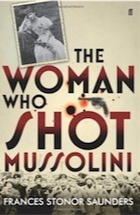Alex Constantine - March 27, 2010
The history of an Irishwoman's attempt to assassinate the Duce is a fine study of Italian fascism, says Ian Thomson
Ian Thomson | The Observer | 28 March 2010
Mussolini was half demagogue, half tinpot Caesar. On occasion he wore a richly tasselled fez and liked to puff up his chest for the cameras, thrusting out his chin pugnaciously. As his regime strengthened in the 1920s, the high priests of fascism hailed their leader as "divine emperor", and even called for an embargo on foreign words. Thus Italians could no longer take a "ferry-boat" but had to travel instead by pontone (pontoon), just as Julius Caesar had done when he invented mobile bridges.
 The Woman Who Shot Mussolini, by Frances Stonor Saunders, 384pp, Faber and Faber, £16.00
The Woman Who Shot Mussolini, by Frances Stonor Saunders, 384pp, Faber and Faber, £16.00
But alongside the bombast, Italian fascism relied on bludgeons and intimidation. During Hitler's occupation of northern Italy, fascist cosh gangs helped to deport more than 6,800 native Jews to Auschwitz. Mussolini made no attempt to justify this enormity; Hitler, at least, was lethally committed to his ideology. In her fine new book, Frances Stonor Saunders implicates the dictator in charges of murder and proto-nazism. Mussolini's 23-year regime, she says, was as meretricious as it was vile.
One woman intuited the danger of fascism early on and determined to eliminate the Duce outright. Violet Gibson, the daughter of a Conservative MP, liked to visit Italy for its art and poetry. In the cult of ducismo she saw a betrayal of parliamentary liberalism and the noble Italy of Dante and the Renaissance. On 7 April 1926, amid a crowd of adoring fascists, she shot the dictator at close range in Rome. The bullet missed Mussolini's head by a fraction, but removed a morsel of flesh from the tip of his nose. The crowd would have lynched Gibson, had the police not intervened and arrested her.
Was she mad? In this biography, Saunders portrays a complex and often violent personality, who thought of herself as both a good Catholic and a self-denying socialist – a sort of Saint Joan of the Workshops. Incredibly, she had come close to changing the fate of European nations. Born in Ireland in 1876, Gibson was a peer's daughter whose Anglo-Protestant background spoke of privilege and conformity. In militant Catholicism, though, she saw a virile alternative to the "effeminate" 1920s, with their flappers, modernist poets and other jazz age frivolities. Having settled in Rome in 1924, she immersed herself in Catholic doctrine and entered a Jesuit retreat.
Jesuits are often regarded by other Catholics as not quite regular clergy (they refuse to be cloistered in a monastery), and Gibson was no exception. Her self-torturing asceticism verged on the holier-than-thou, and her preoccupation with bodily chastisement was akin to that of the desert saints and anchorites, says Saunders. Gibson's attempt on Mussolini's life embarrassed the British government, as the Duce was more widely admired in 1920s Britain than one might think. He was feted in most English newspapers, and was on good terms with George V. For all his slippery diplomacy, Mussolini might have been a useful ally for Britain, historians have argued. But with the Rome-Berlin axis pact of 1939, the Duce hitched his "carnival chariot to the Führer's funeral hearse", and a last chance of peace in Europe was lost. In Italy, notoriously a land of hydra-headed conspiracy theories, it was believed that Gibson was feigning madness to cover up for an assassination plot. Fascist dietrologisti, literally the "behindologists", insisted that cliques and cabals (Soviet Jews, Irish nationalists, American Jesuits) lay behind the attempted murder.
Gibson was probably a lone wolf. Mussolini's view was that she was "insane" and therefore could not be detained as a political criminal. In 1928, two years after the near-fatal gunshot in Rome, Gibson was transferred to a mental home in Northampton, where she remained until her death in 1956, unwept-for and disregarded. In pages of crisp, limpid prose, Saunders brilliantly captures the Irishwoman's spirit and what she might have been. The Woman Who Shot Mussolini is a book of commemoration as well as a documentary, and one of the finest studies of Italian fascism I have read.







